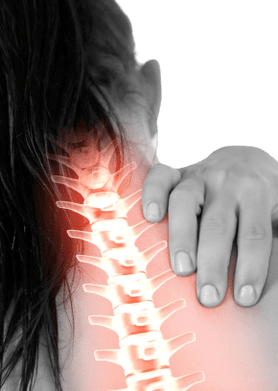Cervical osteochondrosis accounts for about a quarter of all osteochondrosis cases. He is the "youngest" and often affects people under 30. The disease progresses gradually, progressing slowly but steadily. In the early stage of cervical osteochondrosis, it is usually asymptomatic and becomes an accidental discovery during X-ray examination.

Causes of osteochondrosis
The disease is manifested by dull pain, numbness, numbness in the chest, under the shoulder blades, and shoulder area, as well as "goose bumps" and stiffness in the chest. The pain is usually band-like, accompanied by angina, unpleasant pain in the stomach, and shortness of breath. Sometimes short-term acute pain is observed.
The reasons for the destruction of the intervertebral disc and compression of the nerve endings of the spinal cord may be adolescent scoliosis, a sedentary lifestyle, obesity, bearing the same type of load on the spine, and often sitting in a sitting position for long periods of time.
Cervical osteochondrosis: symptoms
The most important, first and most common symptom of cervical osteochondrosis is pain. It is aggravated when bending or turning the head. Depending on the location of the lesion, the pain may appear in the back of the head, under the shoulder blades, or in the arms.
Depending on the location of the lesion, the pain may appear in the back of the head, under the shoulder blades, or in the arms.
It can be continuous and painful. It may happen from time to time, but as the disease progresses, people will become more and more worried. The pain is also severe, shooting. This is a symptom of deterioration of cervical osteochondrosis, which can be manifested after the body's body temperature is hypothermic.
Head movement is usually difficult. This is due to the constant tension of the collar area and neck muscles. When you lean forward or turn your head, you often hear a crunching sound.
In the later stages of cervical osteochondrosis, a person cannot hold his head for a long time. Sometimes he cannot turn or tilt her without experiencing severe pain. The patient tries to support the head with his hands or tries to adopt a comfortable posture to alleviate the pain.
Vertebral artery syndrome

The occurrence of this group of symptoms is due to the displacement of the intervertebral disc, overgrowth of cartilage tissue or tension muscle compression caused by the vertebral artery. The syndrome is a series of symptoms, including neck migraine, disturbance of consciousness, and increased blood pressure.
Neck migraine is a headache caused by reduced blood flow and tissue hypoxia. Pain is often one-sided. The first is the pain in the back of the head. May irradiate ears, eyes or forehead.
Sometimes hearing impairment occurs and the ears begin to ring. Possible visual impairment. In his eyes, "flies flashed" in front of him. The scalp becomes very painful and cannot be touched. Headaches caused by cervical osteochondrosis are often accompanied by nausea and vomiting.
A common symptom of cervical osteochondrosis and vertebral artery compression is increased blood pressure. But cervical osteochondrosis and hypertension are not always related to each other. It should be remembered that in old age, many people experience increased stress.
Only by studying the history of cervical osteochondrosis can doctors determine whether high blood pressure is a complication of the disease. If you have a history of recurrent high blood pressure, accompanied by palpitations and fear of death, this is probably one of the symptoms of vertebral artery compression. If the pressure gradually rises and frequent hypertensive crises are not observed, the patient is likely to have hypertension, which is not related to osteochondrosis.
When the blood supply to the brain is insufficient, consciousness disturbance occurs. Drowsiness, dizziness, and decreased response speed to external stimuli. A short-term loss of consciousness occurs.
Recovery after stroke
What are the most dangerous symptoms of cervical osteochondrosis? There is no doubt that this is a spinal cord stroke-part of the spinal cord died because there was no blood flow in the squeezed blood vessels. It always leads to disability, leading to paralysis and paralysis. Fortunately, spinal strokes are rare.
Heart syndrome
Among the symptoms of deterioration of cervical osteochondrosis, there is heart pain. It occurs because the posterior root of the fourth spinal nerve is squeezed. In fact, heart pain can be attributed to nerve root syndrome. But this symptom is specific and therefore isolated as a separate syndrome.
Heart pain caused by osteochondrosis can mimic angina or myocardial infarction. But when a patient seeks medical help, a competent doctor will immediately rule out heart disease based on the patient's symptoms and main complaint.
- First of all, other symptoms of the patient’s cervical osteochondrosis have led experts to believe that the cause of the heart pain may be spine problems;
- Secondly, the pain is not as intense and severe as myocardial infarction, and it is not accompanied by the fear of death. Contrary to angina pectoris, it has nothing to do with physical activity;
- Third, the pain lasts for a long time, and it does not disappear or even disappear after taking nitroglycerin;
- Fourth, the pain increases when the head is turned or tilted, which is not observed in "real" heart disease.
Nerve root syndrome
Nerve root syndrome combines the symptoms of cervical osteochondrosis due to compression of spinal nerve roots. Depending on the degree of compression, various symptoms of cervical intervertebral osteochondrosis may occur.
Compression of the root at the level of the first or second section causes numbness of the occipital skin or occipital pain.
Squeezing the root of the third spinal nerve can cause numbness of the tongue and the skin behind the ears. If the sports fiber is squeezed, it will be difficult for a person to chew food, and the tongue will feel enlarged.
Compression of the root at the level of the fourth segment of the spinal cord can cause heart and clavicle pain, hiccups, and pharynx migraine. A foreign body sensation in the throat and difficulty swallowing. There may be a sore throat that mimics a sore throat. But the differential diagnosis of cervical osteochondrosis and tonsillitis is not difficult at all. Inflammation of the pharyngeal tonsils is always accompanied by hyperthermia, while cervical osteochondrosis does not raise the body temperature.
Symptoms of cervical osteochondrosis
The most common symptom of squeezing the fifth spinal nerve root is impaired mobility of the shoulder muscles. It is difficult for the patient to raise his hand and move it aside.
Pinching the root of the sixth section most often causes pain in the shoulder blades and forearms. It is difficult for the patient to bend and rotate the forearm.
The seventh pair of spinal nerves mainly innervate the hand, index finger and middle finger. When it is pinched, the movement of these parts of the body is disturbed, and there is numbness or pain.
Pinch at the level of the eighth section to make it difficult to bend and stretch the ring finger and little finger. Pain and sensory disturbances may also occur. However, these manifestations can already be attributed to the symptoms of cervical thoracic osteochondrosis, because the root of the eighth spinal nerve is located between the seventh cervical vertebra and the first thoracic vertebra.
What are the hazards of cervical osteochondrosis? First of all, by its complexity. The appearance of an intervertebral hernia can cause compression of the spinal cord, which can lead to paralysis and paralysis. When the first symptoms of cervical osteochondrosis appear, treatment should be started. The correct choice of treatment will slow down the progression of the disease, improve the patient's quality of life, and avoid the development of complications of cervical osteochondrosis.
























